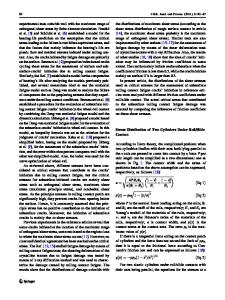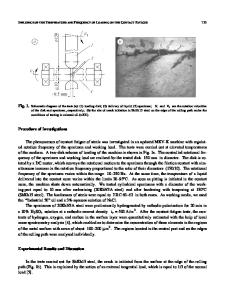Rolling Contact Fatigue and Wear Behavior of High-Performance Railway Wheel Steels Under Various Rolling-Sliding Contact
- PDF / 3,385,181 Bytes
- 14 Pages / 593.972 x 792 pts Page_size
- 13 Downloads / 360 Views
ÓASM International 1059-9495/$19.00
Rolling Contact Fatigue and Wear Behavior of High-Performance Railway Wheel Steels Under Various Rolling-Sliding Contact Conditions Michela Faccoli, Candida Petrogalli, Matteo Lancini, Andrea Ghidini, and Angelo Mazzu` (Submitted July 19, 2016; in revised form March 27, 2017; published online June 19, 2017) An experimental investigation was carried out to study and compare the response to cyclic loading of the high-performance railway wheel steels ER8 EN13262 and SUPERLOSÒ. Rolling contact tests were performed with the same contact pressure, rolling speed and sliding/rolling ratio, varying the lubrication regime to simulate different climatic conditions. The samples, machined out of wheel rims at two depths within the reprofiling layer, were coupled with UIC 900A rail steel samples. The wear rates, friction coefficients and hardness were correlated with the deformation beneath the contact surface. The crack morphology was studied, and the damage mechanisms were identified. The distribution of crack length and depth at the end of the dry tests was analyzed to quantify the damage. The main difference between the steels lies in the response of the external samples to dry contact: SUPERLOSÒ is subjected to a higher wear and lower friction coefficient than ER8, and this reduces the density of surface cracks that can propagate under wet contact conditions. The analysis of feedback data from in-service wheels confirmed the experimental results. Keywords
crack analysis, damage analysis, railway wheel steel, strain hardening, wear rate
1. Introduction The future trend in railway operation is clear: higher train speeds and greater axle loads are being introduced throughout the world. One consequence is that better performance from railway wheels is required. The typical railway wheel life can vary from 300,000 to 2,500,000 km, including two to five reprofilings. There are various deterioration mechanisms that affect the life of a railway wheel (Ref 1, 2), and their study is complex (Ref 3, 4). The contact stresses may lead to rolling contact fatigue (RCF) on the wheel surface or within a subsurface layer (typically between 5 and 25 mm below the surface). Surface-initiated RCF is due to severe plastic deformation (ratcheting) of the surface layer. When surface cracks undergo wet contact due to rain or snow falling at the wheel-rail interface, they can rapidly propagate inward driven by the pressurization of the fluid trapped inside the crack, causing very severe damage (Ref 5). Subsurface-initiated RCF is due to the presence inside the material of microstructural defects, as non-metallic inclusions. The subsurface cracks are rarer than surface cracks, but are extremely dangerous as they are not visible and can propagate until they eventually cause the detachment of a large wheel part (shelling). To prevent the development of crack networks and the formation of shelling, Michela Faccoli, Candida Petrogalli, Matteo Lancini, and Angelo Mazzu`, Department of Mechanical and Industrial Engineering, Univ
Data Loading...










